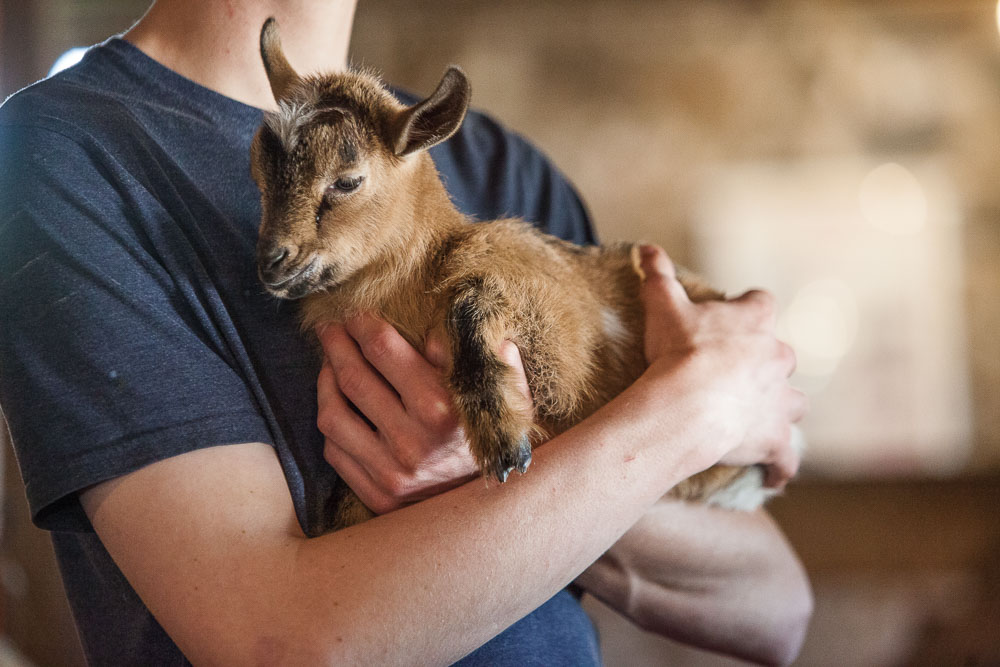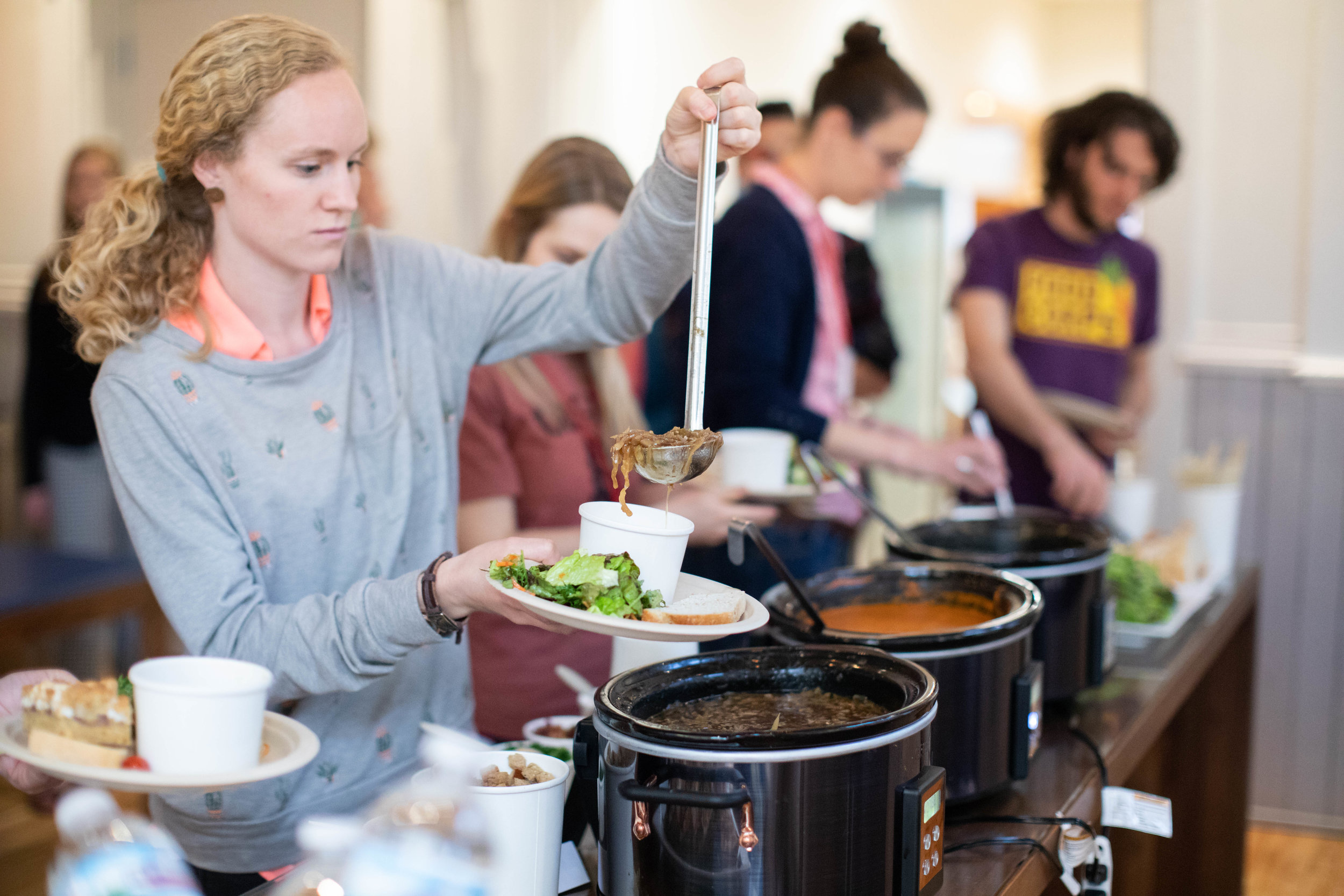Growing Farmers

As the population of farmers who grow our food ages, a new effort in Ohio aims to help beginning farmers follow in their footsteps.
photographs by Mackenzie Frank
Ben and Emily Jackle got interested in organic farming in the mid 2000s. At the time, neither had a background in farming—he had studied music and she was in environmental education—but they, like many young people, were inspired by the growing sustainable food movement. “We felt that farming met all of our goals for a more self-sufficient and healthy lifestyle,” Ben says.
There was just one problem: They had the motivation, but they lacked the know-how.
The couple looked into programs at land-grant universities, but those focused mostly on conventional agriculture. To get hands-on experience, they wound up taking internships on organic farms in Montana and Illinois, and they found the Upper Midwest an area fertile with opportunities to learn about organic farming and network with peers.
When they felt ready to start farming on their own in 2007, they moved to Ohio and started farming on land rented from Ben’s father in New Lebanon. They didn’t find that same organic farming community support here, but they forged ahead and made connections on their own.
Their Mile Creek Farm was certified organic in 2010, and they sell a wide range of organic vegetables at Dayton’s Second Street Market, through their 200-member CSA, and via the Great River Organics co-op.
For every farm success story like the Jackles, there are also stories of failure. Beginning farmers face a number of barriers that no amount of passion can overcome. Access to affordable land and health insurance, student loan debt, and lack of farming knowledge are a few of the biggest challenges, according to Kelly Henderson, Begin Farming Program Coordinator for the Ohio Ecological Food and Farm Association (OEFFA), a grassroots coalition of farmers, consumers, gardeners, chefs, teachers, researchers, retailers, and students working to build a sustainable local food system in Ohio.
We Need New Farmers
Overcoming these barriers for young farmers interested in building sustainable food operations is crucial to the long-term health of our country’s food system. The U.S. is in desperate need of new farmers. Farmers over the age of 55 manage nearly two-thirds of our country’s farmland. In Ohio, the average age of farmers is 58. Many of those farmers are making crucial decisions right now about what to do with their land as they age out of active farming.
“This is a crisis that we’re facing in the country right now. We’re looking at a huge population, about a third of the total farm population, that will be passing their farm on—or potentially not able to pass their farm on if they don’t have someone interested in taking over,” Henderson says. “This presents a huge threat not only to losing that land but also the knowledge that those experienced farmers have.”
Further, Henderson adds, our national security is in danger if we don’t handle this significant transition in our food system correctly.
Because of all of this, OEFFA is working to develop beginning farmers in Ohio through its Heartland Farm Beginning program. Funded by a grant from the U.S. Department of Agriculture’s Beginning Farmer and Rancher Development Program, the year-long program includes 60 hours of classroom time where beginning farmers learn from experienced farmers about whole-farm planning, financial planning, marketing, business planning and management, soil health, and land conservation.
Each beginning farmer is also paired with a mentor farmer who helps them identify goals and put together a business plan. (A beginning farmer, regardless of age, is defined as someone who has been farming 10 years or less or who is planning to start a farm business.)
If successful, this program and others from OEFFA will help build a stronger support network for farmers, create opportunities for skill building and business training, and help steward land from retiring farmers to early career farmers.
Jason Pratt, a new farmer participating in OEFFA’s Heartland Farm Beginning program, launched Indian Springs Berry Farm on his family’s Fairfield-area property. Pratt, right, is a retired Marine Corps pilot who has put his engineering experience to use in building his farm’s growing structures. This is his second harvest year.
Introducing Non-Farmers to Farming
Jason Pratt is one of 10 in the first cohort of OEFFA’s Heartland Farm Beginning program. He recently started Indian Springs Berry Farm, an organic U-pick blackberry farm in Fairfield, OH. A retired Marine Corps pilot in his mid-40s, Pratt doesn’t fit the profile of a “beginning” farmer most people have in mind. He got interested in farming as a way to earn income from the eight-acre property his mother lives on. His family moved there in 1982, when he was 10, but aside from boarding animals, they didn’t farm it.
A friend suggested he look into growing blackberries on the land. He liked that idea, but as an engineer by trade he lacked agricultural knowledge and a network of resources. “I knew enough to do a soil sample, but didn’t know how to interpret the data,” Pratt says.
A survey from the National Young Farmers Coalition found that three-quarters of beginning farmers, like Pratt, don’t come from a farming background. “Most of them are coming with higher education degrees, student loan debt, and lacking that farm-kid knowledge that young farmers that grew up on a farm might have. Social connections to that farming community are so important,” Henderson says.
“OEFFA’s programs have done a nice job of filling in those gaps and expanding my network of people that have the knowledge I need,” Pratt says. Through those connections, he discovered Trellis Growing Systems, a maker of trellising hardware based in Fort Wayne, IN. He invested in that infrastructure and four varieties of blackberries that bloom at different times so that production can stretch from mid-June to mid-August. The plants went in the ground in 2015; he cut them back in 2016 so they would grow more vigorously, and then opened to berry pickers in 2017.
The first summer went well, and Pratt was able to sell most of his big, juicy berries to U-pick customers. He’s already interested in finding more land to expand in the future. He’s off to a good start, but he recognizes that he was in a better position than many farmers looking to start similar operations—he had land in the family, enough resources to finance start-up costs, and a day job that allowed him to wait two years between planting and harvesting to sell his first crop.
“If I was just a starting-out farmer who didn’t have any other income, I’d be bankrupt before I got my first set of berries,” Pratt says.
Pratt’s experience with berry growing systems ended up benefiting one of his classmates. Caroline McColloch, owner of Chez Nous Farm in Piqua, OH, was looking for ways to use land she’d inherited from family. She had started out raising goats for meat and growing vegetables, but the learning curve was steep. After hearing about the berry growing system from Pratt, she decided to focus on raspberries, which command a good price at markets.
As a single woman in her 50s with no working farm background, McColloch has been taking advantage of as many OEFFA opportunities for learning and networking as possible. In starting a farm from scratch on her own, she says, decision-making is her biggest challenge.
“Pretty much every asset I have—the money, my time, my physical constitution—is sunk into this farm,” McColloch says. “It’s very nerve racking thinking that if I don’t make a good decision, then I have wasted everything I’ve worked so hard for.”
Her program mentor, Daniel Trudel of Ann’s Raspberry Farm in Fredericktown, OH, is one of many people she’s found through OEFFA channels that she can bounce ideas off of as she hones her farm business. Through the program she learned about alternative financing options, and she’s working to crowdfund a no-interest loan through microlending site Kiva.org to cover start-up costs for the raspberries. She also learned that she could generate some badly needed income through the Natural Resources Conservation Service by establishing and maintaining monarch butterfly and pollinator habitats. She plans to round that out by also selling herb starts, cut herbs, and honey.
“Caroline is a great example of someone who has started out by learning and focusing on researching and then slowly scaling up her operation,” Henderson says. “I’ve seen her grow her business in a really sustainable manner.”
Sustainability will be a key indicator of success for OEFFA’s program. Henderson says many beginning farmers drop out of farming after two to five years if they don’t have adequate resources to start turning a profit. The program has a history of success in other states, and she’s even seeing new leaders emerge within this first class of beginning farmers. “I think that’s going to be the way we grow the number of beginning farmers—those farmers we’re training now becoming farm leaders down the road,” she says.
Emily and Ben Jackle built their expertise through internships in other states, then established Mile Creek Farm in New Lebanon, OH. Now they mentor newbie farmers.
Paying it Forward
As for the Jackles of Mile Creek Farm, they are helping new farmers get the support they could’ve used when they started. Ben and Emily serve on the advisory council for the program, they offered a beginning farmer focused farm tour, and they are hosting four beginning farmers on their farm as part of OEFFA’s apprentice program this summer.
Ben says he wishes OEFFA’s Begin Farming program had been available when he and Emily got their start. “We would definitely have been more likely to apprentice here,” instead of in Montana and Illinois, he says. The real-world training is essential for those without a farming background, and it supplements what students might learn in a pursuit of an agriculture degree. “You could work on a sustainable agriculture farm at a college and never end up driving a tractor,” he says. “If you really wanted to be a farmer, that’s a pretty essential task to know how to do.”
Pratt and McColloch, too, are poised to become leaders. Pratt hopes to build a berry business that’s attractive for a younger couple to take over one day. And McColloch is motivated to preserve her family’s property as quality farmland for future generations.
“What do I want my legacy to be when I’m no longer here?” she considers. “We’re not in it to get rich. You’re making a sacrifice of sorts for people who come after you, so people can learn how to take care of the Earth. This is my little drop in the bucket.”
Amy is a freelance writer and content strategist with an interest in sustainability, food, and wellness. After 12 years of apartment living in Brooklyn, NY, she's enjoying having space to learn how to grow food in a community garden plot here in Cincinnati. She blogs regularly about sustainability for the nonprofit Sustainable America.







